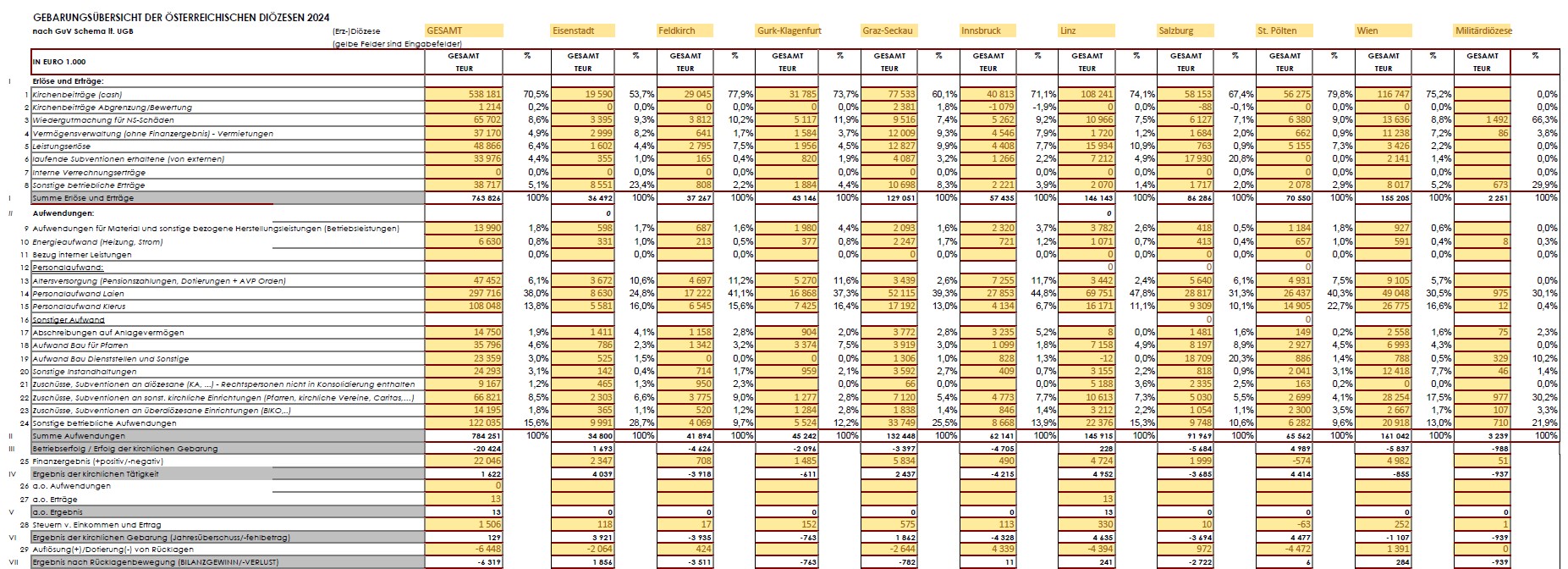Wien – The picture emerging from the Catholic Church’s statistics in Austria for 2024 leaves little room for doubt: the Austrian Church remains an economically robust institution, thanks above all to the Kirchenbeitrag (church tax), yet it continues to experience a season of pastoral and demographic contraction.
A Church losing its faithful
At the end of 2024, the number of registered Catholics stood at 4.56 million out of a population of roughly 9 million. Exits from the Church reached 47,353, while entries and re-entries amounted to just over 7,500. The figures speak clearly: the net decline continues, and the erosion is most evident among young people, increasingly distant from the sacraments.
The data on the sacraments confirm this trend:
Baptisms: 36,705
First Communions: 45,685
Confirmations: 39,677
Marriages: 7,537
Funerals: 71,531
The disproportion between the sacraments of initiation and funerals is striking: in Austria, many return to church almost solely for a gesture of tradition, often linked to the farewell of the deceased. This reveals a deeper crisis: the structuresare strong, but what is lacking is a living faith and credible witness. Without that light, the Church is no longer perceived as a stable and vital point of reference.
The face of the clergy
The clergy reflects this dynamic. In 2024 there were:
1,764 diocesan priests (1,619 residing in their dioceses)
1,193 religious
763 permanent deacons
2,591 religious sisters
The number of priests remains considerable, yet the average age is high and generational replacement fragile. Increasingly, pastoral work is carried forward by permanent deacons and a network of lay volunteers. The question arises: why should a young person today choose the seminary, at a time when the Church itself seems to be experiencing a deep crisis of credibility and meaning? Unsurprisingly, the most promising vocational signs come from religious and monastic communities that preserve their charism with seriousness: where consecrated life is lived authentically, it continues to attract and generate new vocations.
Finances: strong revenues, growing expenses
On the economic front, the Austrian Church remains one of the strongest in Europe. In 2024, the dioceses recorded:
Total revenues: €763.8 million
Total expenses: €784.3 million
Operating result: –€20.4 million
Final balance after reserves: –€6.3 million
The dominant revenue stream is the Kirchenbeitrag, covering on average 70% of diocesan budgets. This is followed by state compensations related to the Nazi period (8.6%), property income and rents (6.4%), pastoral and educational activities (6.4%), while public subsidies account for only 2.1%.
On the expenditure side, the priority remains the maintenance of parishes (43%). Central administration absorbs about 20%, pastoral activities 18%, charity and social works 11%. Only 2% is destined directly for the universal Churchand international cooperation.
The Kirchenbeitrag
The Kirchenbeitrag is the mandatory contribution every registered Catholic in Austria must pay annually to their diocese. Introduced in 1939, after the State stopped direct funding to the Church, it has become the main source of diocesan income. The contribution is calculated on the taxable income of the faithful and corresponds on average to 1.1% of annual net income, with reductions or exemptions for those in economic difficulty, as well as for students, pensioners, or large families. The average payment is around €300–400 per person per year.
Through this system, about 70% of the Church’s total income in Austria comes from the Kirchenbeitrag, which finances salaries of priests and collaborators, as well as pastoral, charitable, and educational activities, plus the maintenance of churches and parishes. Yet it is also the main reason why thousands formally leave the Church each year: official withdrawal is the only way to avoid paying.
Between stability and a crisis of meaning
The numbers portray a contradictory Church: financially solid, but pastorally fragile. Resources guarantee the survival of structures, but without renewed faith they risk supporting only empty buildings.
The challenge awaiting the Austrian Church is therefore twofold: to preserve the trust of contributors, who continue to support its mission, and at the same time to find a language capable of reaching a society that knocks less and less at the doors of its parishes. As Leo XIV reminded the Church of Rome, here too it becomes urgent to foster vocations, to place evangelization and formation back at the center, and to rediscover the radicality of the Gospel as a criterion of life. What is needed is not doctrinal experimentation or figures who bend the Church to worldly logics, but men and women ready to serve with humility and fidelity, because only from authentic witness can a credible community be born again.
p.M.R.
Silere non possum

